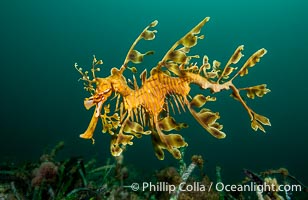
The leafy seadragon (Phycodurus eques) is found on the southern and western coasts of Australia. Its extravagent appendages serve only for camoflage, since it has a nearly-invisible dorsal fin that propels it slowly through the water. The leafy sea dragon is the marine emblem of South Australia.
Species: Leafy seadragon, Phycodurus eques
Location: Rapid Bay Jetty, South Australia
Image ID: 39137
Species: Leafy seadragon, Phycodurus eques
Location: Rapid Bay Jetty, South Australia
Image ID: 39137
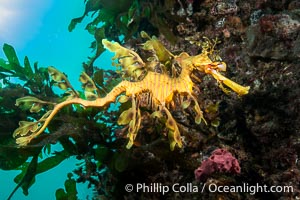
The leafy seadragon (Phycodurus eques) is found on the southern and western coasts of Australia. Its extravagent appendages serve only for camoflage, since it has a nearly-invisible dorsal fin that propels it slowly through the water. The leafy sea dragon is the marine emblem of South Australia.
Species: Leafy seadragon, Phycodurus eques
Location: Rapid Bay Jetty, South Australia
Image ID: 39134
Species: Leafy seadragon, Phycodurus eques
Location: Rapid Bay Jetty, South Australia
Image ID: 39134
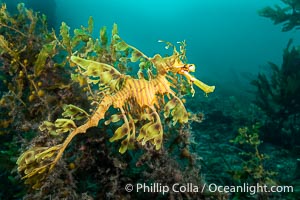
The leafy seadragon (Phycodurus eques) is found on the southern and western coasts of Australia. Its extravagent appendages serve only for camoflage, since it has a nearly-invisible dorsal fin that propels it slowly through the water. The leafy sea dragon is the marine emblem of South Australia.
Species: Leafy seadragon, Phycodurus eques
Location: Rapid Bay Jetty, South Australia
Image ID: 39357
Species: Leafy seadragon, Phycodurus eques
Location: Rapid Bay Jetty, South Australia
Image ID: 39357
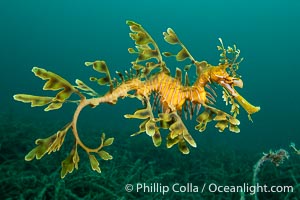
The leafy seadragon (Phycodurus eques) is found on the southern and western coasts of Australia. Its extravagent appendages serve only for camoflage, since it has a nearly-invisible dorsal fin that propels it slowly through the water. The leafy sea dragon is the marine emblem of South Australia.
Species: Leafy seadragon, Phycodurus eques
Location: Rapid Bay Jetty, South Australia
Image ID: 39360
Species: Leafy seadragon, Phycodurus eques
Location: Rapid Bay Jetty, South Australia
Image ID: 39360
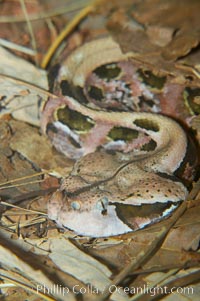
African gaboon viper camouflage blends into the leaves of the forest floor. This heavy-bodied snake is one of the largest vipers, reaching lengths of 4-6 feet (1.5-2m). It is nocturnal, living in rain forests in central Africa. Its fangs are nearly 2 inches (5cm) long.
Species: African gaboon viper, Bitis gabonica
Image ID: 12576
Species: African gaboon viper, Bitis gabonica
Image ID: 12576
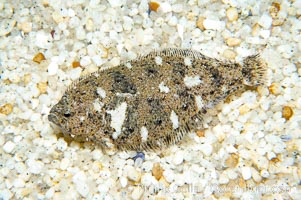
A small (2 inch) sanddab is well-camouflaged amidst the grains of sand that surround it.
Species: Sanddabs, Citharichthys
Image ID: 14936
Species: Sanddabs, Citharichthys
Image ID: 14936
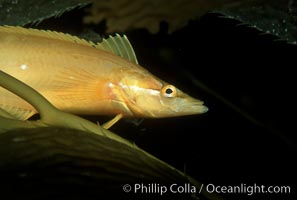
Giant kelpfish amidst kelp.
Species: Giant kelpfish, Heterostichus rostratus, Macrocystis pyrifera
Location: San Clemente Island, California
Image ID: 01291
Species: Giant kelpfish, Heterostichus rostratus, Macrocystis pyrifera
Location: San Clemente Island, California
Image ID: 01291
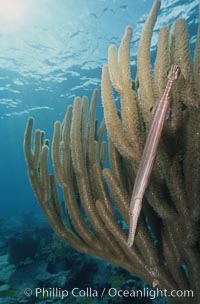
Trumpetfish camouflages itself among the branches of a gorgonian coral (also known as sea rods).
Species: Trumpetfish (atlantic), Aulostomus maculatus, Plexaurella
Location: Bahamas
Image ID: 05210
Species: Trumpetfish (atlantic), Aulostomus maculatus, Plexaurella
Location: Bahamas
Image ID: 05210
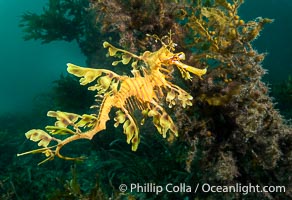
The leafy seadragon (Phycodurus eques) is found on the southern and western coasts of Australia. Its extravagent appendages serve only for camoflage, since it has a nearly-invisible dorsal fin that propels it slowly through the water. The leafy sea dragon is the marine emblem of South Australia.
Species: Leafy seadragon, Phycodurus eques
Location: Rapid Bay Jetty, South Australia
Image ID: 39132
Species: Leafy seadragon, Phycodurus eques
Location: Rapid Bay Jetty, South Australia
Image ID: 39132
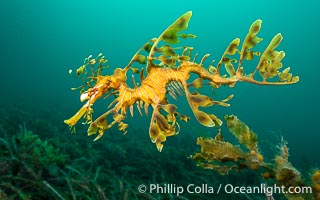
The leafy seadragon (Phycodurus eques) is found on the southern and western coasts of Australia. Its extravagent appendages serve only for camoflage, since it has a nearly-invisible dorsal fin that propels it slowly through the water. The leafy sea dragon is the marine emblem of South Australia.
Species: Leafy seadragon, Phycodurus eques
Location: Rapid Bay Jetty, South Australia
Image ID: 39135
Species: Leafy seadragon, Phycodurus eques
Location: Rapid Bay Jetty, South Australia
Image ID: 39135
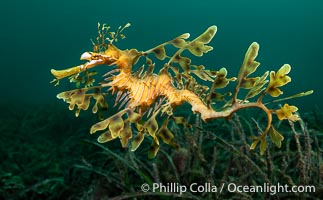
The leafy seadragon (Phycodurus eques) is found on the southern and western coasts of Australia. Its extravagent appendages serve only for camoflage, since it has a nearly-invisible dorsal fin that propels it slowly through the water. The leafy sea dragon is the marine emblem of South Australia.
Species: Leafy seadragon, Phycodurus eques
Location: Rapid Bay Jetty, South Australia
Image ID: 39138
Species: Leafy seadragon, Phycodurus eques
Location: Rapid Bay Jetty, South Australia
Image ID: 39138
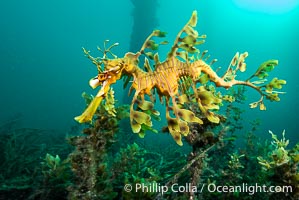
The leafy seadragon (Phycodurus eques) is found on the southern and western coasts of Australia. Its extravagent appendages serve only for camoflage, since it has a nearly-invisible dorsal fin that propels it slowly through the water. The leafy sea dragon is the marine emblem of South Australia.
Species: Leafy seadragon, Phycodurus eques
Location: Rapid Bay Jetty, South Australia
Image ID: 39133
Species: Leafy seadragon, Phycodurus eques
Location: Rapid Bay Jetty, South Australia
Image ID: 39133
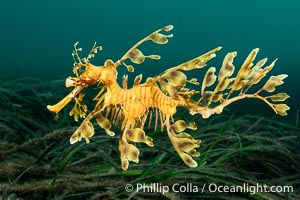
The leafy seadragon (Phycodurus eques) is found on the southern and western coasts of Australia. Its extravagent appendages serve only for camoflage, since it has a nearly-invisible dorsal fin that propels it slowly through the water. The leafy sea dragon is the marine emblem of South Australia.
Species: Leafy seadragon, Phycodurus eques
Location: Rapid Bay Jetty, South Australia
Image ID: 39136
Species: Leafy seadragon, Phycodurus eques
Location: Rapid Bay Jetty, South Australia
Image ID: 39136
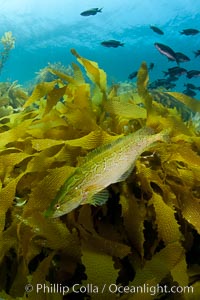
A giant kelpfish swims over Southern sea palms and a kelp-covered reef, mimicing the color and pattern of the kelp leaves perfectly, camoflage.
Species: Giant kelpfish, Southern sea palm, Heterostichus rostratus
Location: San Clemente Island, California
Image ID: 25414
Species: Giant kelpfish, Southern sea palm, Heterostichus rostratus
Location: San Clemente Island, California
Image ID: 25414
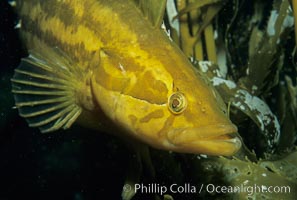
Giant kelpfish in kelp.
Species: Giant kelpfish, Heterostichus rostratus, Macrocystis pyrifera
Location: San Clemente Island, California
Image ID: 05142
Species: Giant kelpfish, Heterostichus rostratus, Macrocystis pyrifera
Location: San Clemente Island, California
Image ID: 05142
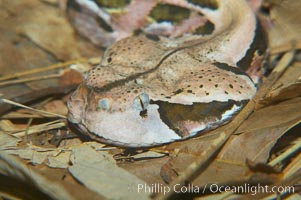
African gaboon viper camouflage blends into the leaves of the forest floor. This heavy-bodied snake is one of the largest vipers, reaching lengths of 4-6 feet (1.5-2m). It is nocturnal, living in rain forests in central Africa. Its fangs are nearly 2 inches (5cm) long.
Species: African gaboon viper, Bitis gabonica
Image ID: 12575
Species: African gaboon viper, Bitis gabonica
Image ID: 12575
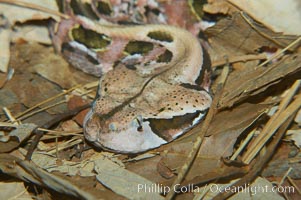
African gaboon viper camouflage blends into the leaves of the forest floor. This heavy-bodied snake is one of the largest vipers, reaching lengths of 4-6 feet (1.5-2m). It is nocturnal, living in rain forests in central Africa. Its fangs are nearly 2 inches (5cm) long.
Species: African gaboon viper, Bitis gabonica
Image ID: 12577
Species: African gaboon viper, Bitis gabonica
Image ID: 12577
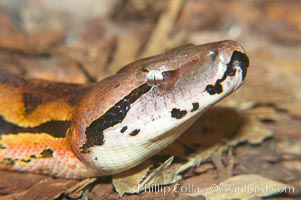
Malagasy ground boa. The ground boa is the largest boa species in Madagascar, reaching 10 feet (3m) in length. Its coloration provides excellent camouflage amid rocks, logs and bushy thickets. It is mainly nocturnal, hunting birds and small mammals.
Species: Malagasy ground boa, Acrantophis madagascariensis
Image ID: 12594
Species: Malagasy ground boa, Acrantophis madagascariensis
Image ID: 12594
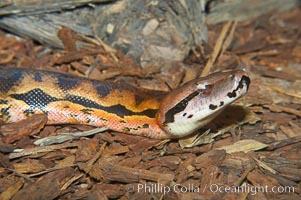
Malagasy ground boa. The ground boa is the largest boa species in Madagascar, reaching 10 feet (3m) in length. Its coloration provides excellent camouflage amid rocks, logs and bushy thickets. It is mainly nocturnal, hunting birds and small mammals.
Species: Malagasy ground boa, Acrantophis madagascariensis
Image ID: 12595
Species: Malagasy ground boa, Acrantophis madagascariensis
Image ID: 12595
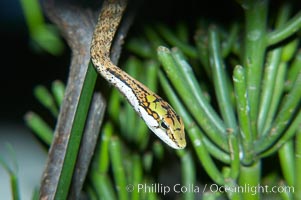
Twig snake. The twig snake is back-fanged, having its short fangs situated far back in the mouth. Its venom will subdue small prey such as rodents. Its is well camouflaged, resembling a small twig or branch in the trees that it inhabits.
Species: Twig snake, Thelotornis capensis oatesii
Image ID: 12605
Species: Twig snake, Thelotornis capensis oatesii
Image ID: 12605
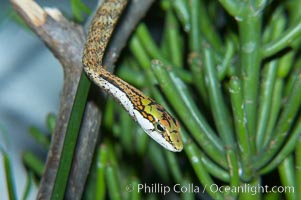
Twig snake. The twig snake is back-fanged, having its short fangs situated far back in the mouth. Its venom will subdue small prey such as rodents. Its is well camouflaged, resembling a small twig or branch in the trees that it inhabits.
Species: Twig snake, Thelotornis capensis oatesii
Image ID: 12606
Species: Twig snake, Thelotornis capensis oatesii
Image ID: 12606
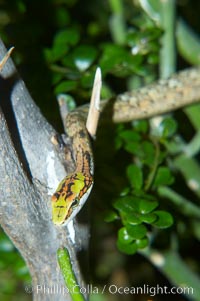
Twig snake. The twig snake is back-fanged, having its short fangs situated far back in the mouth. Its venom will subdue small prey such as rodents. Its is well camouflaged, resembling a small twig or branch in the trees that it inhabits.
Species: Twig snake, Thelotornis capensis oatesii
Image ID: 12607
Species: Twig snake, Thelotornis capensis oatesii
Image ID: 12607
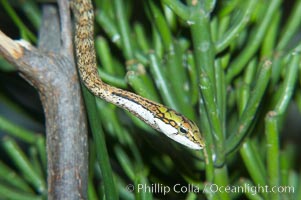
Twig snake. The twig snake is back-fanged, having its short fangs situated far back in the mouth. Its venom will subdue small prey such as rodents. Its is well camouflaged, resembling a small twig or branch in the trees that it inhabits.
Species: Twig snake, Thelotornis capensis oatesii
Image ID: 12608
Species: Twig snake, Thelotornis capensis oatesii
Image ID: 12608
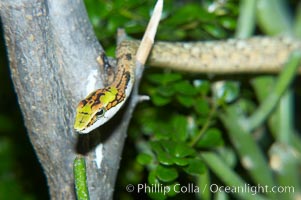
Twig snake. The twig snake is back-fanged, having its short fangs situated far back in the mouth. Its venom will subdue small prey such as rodents. Its is well camouflaged, resembling a small twig or branch in the trees that it inhabits.
Species: Twig snake, Thelotornis capensis oatesii
Image ID: 12609
Species: Twig snake, Thelotornis capensis oatesii
Image ID: 12609
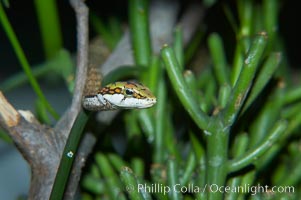
Twig snake. The twig snake is back-fanged, having its short fangs situated far back in the mouth. Its venom will subdue small prey such as rodents. Its is well camouflaged, resembling a small twig or branch in the trees that it inhabits.
Species: Twig snake, Thelotornis capensis oatesii
Image ID: 12610
Species: Twig snake, Thelotornis capensis oatesii
Image ID: 12610
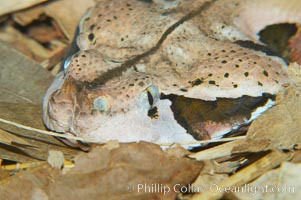
African gaboon viper camouflage blends into the leaves of the forest floor. This heavy-bodied snake is one of the largest vipers, reaching lengths of 4-6 feet (1.5-2m). It is nocturnal, living in rain forests in central Africa. Its fangs are nearly 2 inches (5cm) long.
Species: African gaboon viper, Bitis gabonica
Image ID: 12737
Species: African gaboon viper, Bitis gabonica
Image ID: 12737
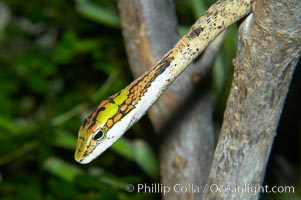
Twig snake. The twig snake is back-fanged, having its short fangs situated far back in the mouth. Its venom will subdue small prey such as rodents. Its is well camouflaged, resembling a small twig or branch in the trees that it inhabits.
Species: Twig snake, Thelotornis capensis oatesii
Image ID: 12816
Species: Twig snake, Thelotornis capensis oatesii
Image ID: 12816
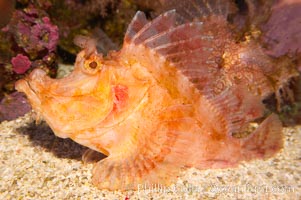
Weedy scorpionfish. Tropical scorpionfishes are camoflage experts, changing color and apparent texture in order to masquerade as rocks, clumps of algae or detritus.
Species: Weedy scorpionfish, Rhinopias frondossa
Image ID: 12897
Species: Weedy scorpionfish, Rhinopias frondossa
Image ID: 12897
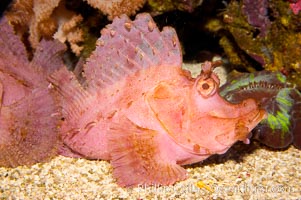
Weedy scorpionfish. Tropical scorpionfishes are camoflage experts, changing color and apparent texture in order to masquerade as rocks, clumps of algae or detritus.
Species: Weedy scorpionfish, Rhinopias frondossa
Image ID: 12898
Species: Weedy scorpionfish, Rhinopias frondossa
Image ID: 12898
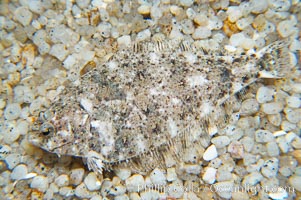
A small (2 inch) sanddab is well-camouflaged amidst the grains of sand that surround it.
Species: Sanddabs, Citharichthys
Image ID: 14004
Species: Sanddabs, Citharichthys
Image ID: 14004